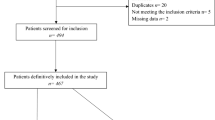Abstract
Background
Diabetic Charcot neuroarthropathy (DCN) is a devastating complication for people with diabetes mellitus. The failure to diagnose DCN and institute treatment in the acute phase leads to permanent deformity and significant morbidity. There is a paucity of data on the prevalence and characteristics of patients who have developed this complication of diabetes.
Aims
To determine the prevalence, clinical characteristics and outcomes of patients with DCN from 2006 to 2012.
Methods
Case finding was performed by searching three independent lists for the period 2006–2012 including: SYNGO radiology database, HIPE database of hospital discharges, and, combined list from podiatry, endocrinology, vascular surgery and orthopaedic clinics. A consensus meeting with chart review was undertaken to confirm diagnosis of DCN. A proforma was completed from chart review to determine clinical characteristics, initial treatment and outcomes for patients with DCN.
Results
Forty cases of DCN were identified, resulting in an estimated period prevalence of 0.3 %. The majority of patients were male (68 %); most patients had T2DM (73 %). Mean ± SD for age was 58 ± 10 years and mean duration of diabetes was 15 ± 9 years. In the acute phase of DCN, offloading was performed in 50 %. Bisphosphonates were administered to 5 % and surgery undertaken in 5 % of cases. 38 % of patients developed subsequent foot ulceration and 20 % required amputation.
Conclusions
This is the first prevalence estimate of DCN in Ireland. These data suggest diagnosis of DCN is missed in the acute phase. There exists a significant risk of diabetic foot ulceration and amputation with DCN.


Similar content being viewed by others
References
Game FL, Catlow R, Jones GR, Edmonds ME, Jude EB, Rayman G, Jeffcoate WJ (2012) Audit of acute Charcot’s disease in the UK: the CDUK study. Diabetologia 55:32–35
Rogers LC, Frykberg RG, Armstrong DG, Boulton AJ, Edmonds M, Van GH, Hartemann A, Game F, Jeffcoate W, Jirkovska A, Jude E, Morbach S, Morrison WB, Pinzur M, Pitocco D, Sanders L, Wukich DK, Uccioli L (2011) The Charcot foot in diabetes. Diabetes Care 34(9):2123–2129
Gouveri E, Papanas N (2011) Charcot osteoarthropathy in diabetes: a brief review with an emphasis on clinical practice. World J Diabetes 2(5):59–65
Jude EB, Selby PL, Burgess J, Lilleystone P, Mawer EB, Page SR, Donohoe M, Foster AV, Edmonds ME, Boulton AJ (2001) Bisphosphonates in the treatment of Charcot neuroarthropathy: a double-blind randomised controlled trial. Diabetologia 44:2032–2037
Pitocco D, Ruotolo V, Caputo S, Mancini L, Collina CM, Manto A, Caradonna P, Ghirlanda G (2005) Six-month treatment with alendronate in acute Charcot neuroarthropathy. Diabetes Care 28:1214–1215
Anderson JJ, Woelffer KE, Holtzman JJ, Jacobs AM (2004) Bisphophonates for the treatment of Charcot neuroarthropathy. J Foot Ankle Surg 43:2285–2289
Richard JL, Almasri M, Schuldiner S (2012) Treatment of acute Charcot foot with bisphosphonates: a systematic review of the literature. Diabetologia 55(5):1258–1264
Rubio JA, Aragón-Sánchez J, Jiménez S, Guadalix G, Albarracín A, Salido C, Sanz-Moreno J, Ruiz-Grande F, Gil-Fournier N, Álvarez J (2014) Reducing major lower extremity amputations after the introduction of a multidisciplinary team for the diabetic foot. Int J Low Extrem Wounds 13(1):22–26
Jeffcoate WJ, Game F, Cavanagh PR (2005) The role of proinflammatory cytokines in the cause of neuropathic osteoarthropathy (acute Charcot foot) in diabetes. Lancet 366:2058–2061
Author information
Authors and Affiliations
Corresponding author
Ethics declarations
Funding
There was no funding obtained for this study.
Conflict of interest
No author has a conflict of interest to declare.
Ethical approval
This article does not contain any studies with human participants performed by any of the authors. The project was reviewed by the institutional audit committee at St. Vincent’s University Hospital and approval was obtained to proceed with data collection.
Rights and permissions
About this article
Cite this article
O’Loughlin, A., Kellegher, E., McCusker, C. et al. Diabetic charcot neuroarthropathy: prevalence, demographics and outcome in a regional referral centre. Ir J Med Sci 186, 151–156 (2017). https://doi.org/10.1007/s11845-016-1508-5
Received:
Accepted:
Published:
Issue Date:
DOI: https://doi.org/10.1007/s11845-016-1508-5




